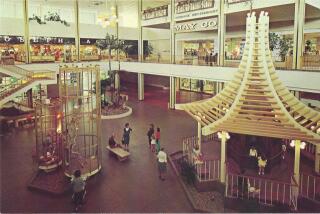The Great Malls of China
- Share via
The news that China is now more popular around the world than the United States, according to a Pew Research Center survey, is just the latest Chinese challenge to the American ego. The Chinese are also buying U.S. businesses with hallowed American brand names, such as IBM (its PC unit), and they’re bidding for Maytag and Unocal. They’re making a lot of what Americans wear, use and buy. They hold a substantial interest in the U.S. future by financing much of the national debt.
And they’ve even surpassed us in the most characteristic icon of American life: the shopping mall.
The Mall of America in Minnesota has been the biggest in the U.S. for more than a decade, and the North American title goes to the mall in West Edmonton, Canada. But this year the largest mall in the world is the Golden Resources Mall in Beijing, and it will soon be eclipsed by the South China Mall. There are now four malls in China that are bigger than the Mall of America. South China Mall will be three times its size.
By the end of the decade, China is expected to have at least seven of the world’s 10 largest shopping malls; it has 400 malls now. In the U.S., mall construction is steadily declining -- from 35 major projects at the turn of the 21st century to just eight projected for 2004-06.
Of course, the U.S. has a half-century head start and China’s vastness is mostly devoid of malls. But this trend does suggest a few things. China has become one of the world’s primary producers of retail goods, based partly on its ability to undercut prices with cheaper labor. Yet there is so much money flowing into China that a consumption economy is growing fast. The customer potential in China and the Far East is one reason that the Simon Property Group, by far the largest U.S. shopping mall developer, opened an office in Hong Kong in May.
Chinese producers are supplying cheap consumer goods sold in the U.S., mostly at Wal-Mart and other low-price retailers, resulting in a huge trade imbalance. This is evident at the ports of Los Angeles and Long Beach, where nearly half of total U.S. imports arrive. As Long Beach communications director Yvonne Smith told PBS’ “Frontline,” “China is doing the manufacturing; the United States is buying it.”
Much of the $3 billion in U.S. exports to China consists of cotton, scrap metal and waste paper used to make $36 billion worth of mostly manufactured goods (and the boxes they arrive in) coming from China -- and that is just what goes through Long Beach.
Meanwhile, the middle class that once filled America’s malls is declining. The U.S. mall industry anticipated a splintering middle class in the 1980s, responding with fashion malls for the better-off and emphasizing entertainment to attract what was left of the mass market. Then Wal-Mart came along and stole the growing low-price consumer market, becoming the world’s largest retailer as well as China’s best customer. That relationship helped accelerate the loss of U.S. manufacturing jobs. So what was once unheard of is now becoming more common: U.S. malls closing down.
In China, an increasing number of consumers can go to American-style shopping malls to buy products with U.S. brand names that are made in China. To some, the specter of a communist country spawning so much business enterprise so successfully seems ironic at best. Others point to all this commerce as the final, if unacknowledged, triumph of capitalism over Marxism. But the lessons learned may be a little different.
The U.S. has managed to avoid widespread conflict over economic inequities by making sure that, even though many people can’t afford healthcare, retirement or higher education, with an extra job or two they can still afford to shop for Chinese-made goods. The Chinese may be learning that this method of pacifying the population is not such a bad idea -- shopping may be the true opiate of the people.
More to Read
Inside the business of entertainment
The Wide Shot brings you news, analysis and insights on everything from streaming wars to production — and what it all means for the future.
You may occasionally receive promotional content from the Los Angeles Times.










